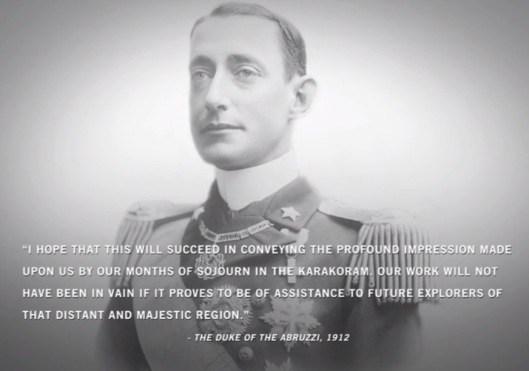Tags
Adam Forslund, Dave Ohlson, Fabrizio Zangrilli, Gerlinde Kaltenbrunner, Jonathan Haidle, Simone Leorin, The Duke of the Abruzzi

This is a pretty epic documentary about a 2009 expedition trying to summit the world’s second highest mountain on the centenary of the first expedition attempted by the Italian geographer, the Duke of Abruzzi, in 1909. I’m a big fan of Into Thin Air by Jon Krakauer and other mountaineering and survival literature, and I happened across this documentary while scrolling through Netflix. The movie highlights the incredibly dangerous, histrionic, yet also numinously appealing sport of extreme mountaineering.
K2 is the crowning peak of the imposing and majestic Karakoram mountain range in Balistan region, Pakistan, at the western end of the Lesser Himalayas. K2 towers over the valley of the Baltoro glacier, which has carved a basin into the Shigar River, one of the tributaries of the Indus, around which the enormous mountains, including four of the 14 world-class “8000” meter peaks, arise. K2, 28,250 feet in elevation, is generally considered one of the most difficult, dangerous, and technically challenging mountains on earth, and is only 750 feet lower in elevation than Mount Everest. The mountain is not only difficult to access but also more difficult to ascend. One quarter of all mountaineers attempting the summit have been killed (compare with 5% for Everest, with nearly 4,560 summits). Not many more than 300 people, since the 31 July 1954 ascent of Achille Compagnoni and Lino Lacedelli, have achieved a summit bid. 11 people were killed while descending from the summit of the mountain in 2008, literally buried in a huge glacial avalanche right at the peak, the tragic 2008 K2 disaster, the year before this film was made. K2 was the setting for the movie Vertical Limit from 2000.
The expedition is led by legendary mountaineer and professional guide, now involved with Aspen Expeditions Colorado, Fabrizio Zangrilli. Zangrilli seemingly possesses a deathwish: he considers the Everest market flooded, and describes K2 as a “proving ground”,- guiding for film crews is a lot like “herding cats”. He speaks about “collecting” the world’s fourteen 8,000 meter peaks, living for the intense emotional and physical high of Summit Day. In 2000, Zangrilli and American Billy Pierson pioneered a K2 summit route now named for them, although they were unable to summit because Zangrilli decided to rescue Pakistan’s Mohammed Ali Junjoba, who had passed out, also attempting to summit. The team includes 8,000 meter peak veteran alpineist, and no-oxygen purist, Austrian Gerlinde Kaltenbrunner; considered the strongest climber on the team. Englishman and natural Jake Meyer, plus Canadian guide Chris Szymiec, are accompanying Adam Forslund, the 16mm cameraman, and Dave Ohlson, who shot the still photographs. Ohlson is credited as the documentary’s director.
After arriving in Islamabad, and making their way by treacherous road to the glacier, the team rests with their porters at the stunning Concordia basecamp. It’s about 20 minutes into the film before someone dies. Veteran Italian mountaineer, Michele Fait is killed while descending by skiis with his partner. The team remains stoic and starts their acclimatization phase by Day 17. They’re at 17,000 feet, 5,000 meters. Resting for a week, they have time to stop by the Art Gilkey memorial to those who were killed in the 1953 American expedition, which now chronicles the litany of those amazing but insane risk taking mountaineers who died on K2, such as Canadian Jeff Lakes, killed in 1995. Team leader Zangrilli reflected on the seven friends he has lost attempting to climb in the Karakoram mountains.
By day 43 they’re approaching their time window for July 26. They make Camp 4 on July 26, and Zangrilli declines the summit attempt, being physically exhausted. But Ohlson, and Kaltenbrunner go for a summit bid, however, they are also forced to turn back when they encounter an impossible approach. They keep in mind that 31 people have died descending K2. By day 51, 30 July 2009, the other teams (Japanese expedition, Pakistani expedition) that year hold a meeting to prepare for the following week’s window, Tuesday, August 4th. On Day 52 the team starts for Camp 4. Physically weakened, exhausted, and demoralized, Meyer gives in. Meyer considers success conditional on the climber’s successful physical return, as well as the team’s survival, and thus goes on to describe the summit as, a “bonus”. He eventually joins the British Army.


From their position on the “Shoulder” of the mountain the climbers can make their way up the ice covered, “Bottlekneck”, avoiding the loose rock opposite, but putting everyone at risk of avalanche. Eventually they turn back, having accomplished the mission of getting amazing photography, and making it as far as their colleagues of the previous year did before they had been killed descending. No one summited K2 during 2009 or 2010. Kaltenbrunner and Zangrilli try K2 again in 2010, Kaltenbrunner- after having just summited Everest the previous season- but are again unable to summit. Attempting K2’s North Face, from the Chinese side, Kaltenbrunner is able to summit K2 successfully in August 2011, although Zangrilli’s own efforts that year were again unsuccessful. Kaltenbrunner becomes National Geographic’s Explorer of the Year in 2012. The film is dedicated to Fredrik Ericsson and Michele Fait, the latter the skiier who was killed at the beginning, and his partner, who later died mountaineering during the film’s production.
Simone Leorin provided the narration, playing the 1909 expedition photographer working for the Duke of Abruzzi, Prince Luigi Amedeo, Arctic Explorer, and Rear Admiral, Inspector of Torpedo Craft 1911-1912, Vice Admiral, Taranto Fleet Base C-in-C 1914-1917), and Jonathan Haidle did the music, which is composed of lovely Philip Glass style piano pieces. The film cost $210,000 to make and was sponsored by a wide range of companies (finance, hiking equipment and energy bars). There is apparently a DVD version that has some extra documentary footage. With a 75 minute running time, the film grossed only $6,947 dollars.
